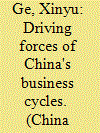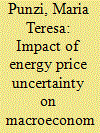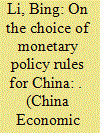|
|
|
Sort Order |
|
|
|
Items / Page
|
|
|
|
|
|
|
| Srl | Item |
| 1 |
ID:
175259


|
|
|
|
|
| Summary/Abstract |
This study mainly aims to assess the impact of an oil revenue shock on Iran's macroeconomic variables using a New Keynesian DSGE model as well as considering some main resource-rich developing countries characteristics such as capital scarcity, government's dominance in the economy, and public investment inefficiencies features. Here, the macroeconomic outcomes of implementing an alternative fiscal rule, namely, modified Bird-in-Hand (MBIH), in which both the development of infrastructures and future generations needs are taken into account are investigated and compared with the fiscal rule of the base scenario. The results are considered in four directions: First, an oil revenue increase shock causes the macroeconomic variables to rise in both scenarios, but the variables private-sector production, consumption, total investment, and non-oil GDP have a more increase under the MBIH scenario. Second, oil revenue accumulation in the oil fund under the MBIH scenario is significantly more than that in the base scenario. Third, government budget deficit experiences a higher increase, and public sector production experiences a less rise under the MBIH scenario. Fourth, the sensitivity analysis of public investment inefficiency shows that this factor acts as a serious barrier to the realization of the government's investment goals. Therefore, performing the first-best (MBIH) fiscal rule entails the reduction of the government's budget dependency on oil revenues through expanding the tax base, improving the public investment efficiency, and shrinking the public sector.
|
|
|
|
|
|
|
|
|
|
|
|
|
|
|
|
| 2 |
ID:
187834


|
|
|
|
|
| Summary/Abstract |
We study the approximate sources of China's business cycles in an estimated dynamic stochastic general equilibrium (DSGE) model with housing and banking. The model replicates well the volatility and cyclicality of key macroeconomic variables observed in the past two decades in China. A host of shock decomposition exercises demonstrate that, among the shocks being considered, both financial and housing shocks are driving China's business cycles, accounting for a particularly large fraction of the variance in most macroeconomic and financial variables at the business cycle frequencies. In particular, the capital quality, housing demand, and loan-to-value shocks display prominent contributions to the business cycle fluctuations. Moreover, there exists substantial interactions between the banking and housing sectors in China, where the collateral constraint and the financial constraint amplify with each other. The results shed new light in the understanding of China's business cycles, and may serve as a useful benchmark for future quantitative analyses of China's macroeconomic fluctuations using DSGE frameworks.
|
|
|
|
|
|
|
|
|
|
|
|
|
|
|
|
| 3 |
ID:
166574


|
|
|
|
|
| Summary/Abstract |
This paper evaluates the macroeconomic implications of energy price volatility through the lens of a dynamic stochastic general equilibrium (DSGE) model in an open economy. The model develops a small open economy in which households consume energy products and firms use energy as productivity inputs, where the country is so small that it needs to import energy, the price of which is determined abroad. Whereas positive energy price shocks cause an economic slowdown due to higher costs for consumers and firms, energy price volatility shocks generate an increase in GDP in the short-run and a reversal in the long-run. These findings are empirically supported by estimates from a Panel VAR model applied to 10 Asian economies, where energy price volatility has a positive impact on GDP in the short-run. Moreover, the paper finds that increasing demand or supply uncertainty also affect energy prices, with amplified fluctuations relative to a model that abstracts from energy. Market volatility leads households to cut consumption for precautionary savings motives, which in turn increases investment.
|
|
|
|
|
|
|
|
|
|
|
|
|
|
|
|
| 4 |
ID:
180115


|
|
|
|
|
| Summary/Abstract |
While the retirement of fossil fuel capacity is an inevitable consequence of the energy transition to carbon neutrality, policymakers face challenges in setting the pace in order that the energy transition policies do not significantly damage the economy. This paper designs a dynamic stochastic general equilibrium (DSGE) model to examine the macroeconomic effects of coal capacity cut policy (CCP) shocks on the Chinese economy. The results show that: firstly, an energy policy shock can distort the transmission effect of coal supply and demand and other factors on coal prices. Secondly, the impact of different policy tools is significantly different on the macroeconomic system, in which the economic effect of advanced capacity replacement is the weakest. Thirdly, in the short term, no matter which policy tool is adopted, the CCP will inevitably lead to a reduction in social welfare levels. The study suggests that in the short term, the Chinese government can further release more replacement quotas of capacity with advanced production efficiency, and innovate other policy tools for coal industrial structural optimization and synergistic effects with environmental regulation. In addition, the results highlight the need for market mechanisms to further accelerate the energy transition over the long run.
|
|
|
|
|
|
|
|
|
|
|
|
|
|
|
|
| 5 |
ID:
187814


|
|
|
|
|
| Summary/Abstract |
This paper proposes a susceptible-infected-removed dynamic stochastic general equilibrium (SIR-DSGE) model to assess the macroeconomic impact of the recent COVID-19 outbreak. The parameters of the SIR setting are calibrated to COVID-19 data from China. Using the model, we illustrate how the pandemic could result in consumption and output loss. We show that a combination of quarantine policy and random testing of the uninfected is effective in reducing the number of infected individuals and outperforms the alternative scenarios in which only one of the policies is implemented. Moreover, the economic impacts of both policies are evaluated. Compared with the decentralized equilibrium, we find that the Ramsey social planner allows output to decrease more substantially during the pandemic, in exchange for a faster economic recovery.
|
|
|
|
|
|
|
|
|
|
|
|
|
|
|
|
| 6 |
ID:
159054


|
|
|
|
|
| Summary/Abstract |
Motivated by the institutional features of China's monetary policy, this paper aims at identifying the most data favored monetary policy rule for China within a dynamic stochastic general equilibrium (DSGE) model framework. In a canonical New-Keynesian DSGE model, we carry out a positive analysis by employing Bayesian methods to estimate three main categories of monetary policy rules, namely a Taylor-type interest rate rule, a money growth rule and an expanded Taylor rule with money. Based on China's quarterly data from 1996Q2 to 2015Q4, our estimation shows that the expanded Taylor rule obtains the best empirical fit to the data. Moreover, impulse responses and forecast error variance decompositions demonstrate that monetary policy rules with or without money provide very different implications for the policy behavior. Our results ultimately suggest that money has so far been more closely targeted than nominal interest rate and still plays an important role as a monetary policy target in China. Furthermore, a conventional Taylor-type interest rate rule is not good enough yet to describe China's monetary policy behavior.
|
|
|
|
|
|
|
|
|
|
|
|
|
|
|
|
|
|
|
|
|